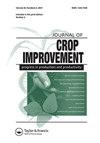提高海军豆罐头质量的遗传、环境和成分因素
IF 1.5
Q3 AGRONOMY
引用次数: 2
摘要
海军豆(Phaseolus vulgaris L.)是豆制品罐头工业的重要原料。本文综述了影响海军蓝豆罐头品质性状的籽粒组成因素,以及开发具有优良罐头品质性状的基因型的育种方法和策略。用于豆类罐头工业的品种应符合既定的罐头质量标准,而不管其产量潜力如何。许多表型质量参数被用来预测基因型的最终罐装质量。主要质量参数包括洗净重量、加工质量指标和织构。这些性状的表型分型非常昂贵,而且需要的籽粒数量只能在高级子代中获得,因此很难进行育种。分子标记辅助选择对提高海军豆罐头品质的作用还不大。然而,它具有促进几种罐头品质性状遗传改良的潜力。审查文件最后提出了一些建议。有必要协调育种者和加加工者对罐装质量的协议和标准,开发和发布结合高铁和锌含量、耐旱性和良好罐装品质的海军豆品种,以及在多种环境下对基因型进行评估。有必要确定与罐头质量和耐旱性有关的稳定和特别适应的基因型,加快确定与罐头质量性状有关的分子标记;并以需求为主导的主流养殖养殖方案,满足市场需求。本文章由计算机程序翻译,如有差异,请以英文原文为准。
Canning quality improvement in navy beans: genetic, environmental and compositional factors
ABSTRACT Navy bean (Phaseolus vulgaris L.) provides important raw materials for the bean canning industry. This article reviews grain compositional aspects influencing the canning and quality attributes of canned navy beans and breeding methodologies and strategies used to develop genotypes with superior canning-quality traits. Cultivars that are destined for the bean canning industry should meet the set canning-quality standards regardless of their yield potential. A number of phenotypic quality parameters are used to predict the final canning quality of genotypes. Primary quality parameters mainly comprise washed drained weight, processing quality index, and texture. Phenotyping for these traits is very expensive and requires grain quantities that can only be obtained in the advanced filial generations, making it difficult to breed for. Molecular marker-assisted selection has not yet contributed much to the improvement of canning quality in navy beans. However, it has the potential to facilitate the genetic improvement of several canning-quality traits. The review paper concludes with a number of recommendations. There exists a need for harmonizing protocols and standards for canning quality by breeders and processors, development and release of navy bean cultivars that combine high grain Fe and Zn content and drought tolerance with good canning qualities, and evaluation of genotypes across a number of environments. A need exists to identify stable and specifically adapted genotypes with respect to canning quality and drought tolerance, hasten the identification of molecular markers that are linked to canning-quality traits; and mainstream demand-led breeding in breeding programs to satisfy the market requirements.
求助全文
通过发布文献求助,成功后即可免费获取论文全文。
去求助
来源期刊

Journal of Crop Improvement
Multiple-
CiteScore
3.30
自引率
7.70%
发文量
42
期刊介绍:
Journal of Crop Science and Biotechnology (JCSB) is a peer-reviewed international journal published four times a year. JCSB publishes novel and advanced original research articles on topics related to the production science of field crops and resource plants, including cropping systems, sustainable agriculture, environmental change, post-harvest management, biodiversity, crop improvement, and recent advances in physiology and molecular biology. Also covered are related subjects in a wide range of sciences such as the ecological and physiological aspects of crop production and genetic, breeding, and biotechnological approaches for crop improvement.
 求助内容:
求助内容: 应助结果提醒方式:
应助结果提醒方式:


